
Exposé Online
What's old
Exposé print issues (1993-2011)
- 1 (October 1993)
- 2 (February 1994)
- 3 (May 1994)
- 4 (August 1994)
- 5 (October 1994)
- 6 (March 1995)
- 7 (July 1995)
- 8 (November 1995)
- 9 (March 1996)
- 10 (August 1996)
- 11 (February 1997)
- 12 (May 1997)
- 13 (October 1997)
- 14 (February 1998)
- 15 (July 1998)
- 16 (January 1999)
- 17 (April 1999)
- 18 (November 1999)
- 19 (May 2000)
- 20 (October 2000)
- 21 (March 2001)
- 22 (July 2001)
- 23 (December 2001)
- 24 (April 2002)
- 25 (September 2002)
- 26 (February 2003)
- 27 (August 2003)
- 28 (December 2003)
- 29 (April 2004)
- 30 (September 2004)
- 31 (March 2005)
- 32 (September 2005)
- 33 (May 2006)
- 34 (March 2007)
- 35 (January 2008)
- 36 (October 2008)
- 37 (July 2009)
- 38 (July 2010)
- 39 (Summer 2011)
Features
The Virtue of Keeping It Small —
Seaprog 2013 from the Inside

Presenting a music festival in today's musical landscape is a daunting proposition. Rather than try to emulate the major music festivals like NEARfest or ProgDay, when my fellow organizers and I decided to put one together in Seattle, we made a conscious choice to keep it small and intimate. We selected a historic theater as a venue and a selection of mostly local artists. When the opportunity arose, we booked Thinking Plague and miRthkon to add some broader geographic appeal.
by Jon Davis, Published 2013-09-21
photography by Danette Davis
The story of how Seaprog came about has been told elsewhere, so here I'll concentrate on an overview of how it unfolded from the viewpoint of a member of the Central Committee. One thing I'd like to point out is that the Committee members are all musicians, and we all included our own bands on the bill. This inaugural festival was originally intended to showcase area bands who operated in the same general musical space as we do, namely rock outside the boundaries of the indie and metal genres which get most of the attention in Seattle. Every one of the local bands on the bill has been out there on the Seattle club circuit, and Committee members have seen them play, so we knew they were up to the task. Putting our own bands on the bill was a kind of insurance, as we knew exactly what to expect. When it comes to the 2014 festival, we'll be more flexible, partly to avoid repetition, and partly because we are more confident we can pull it off.
The Columbia City Theater turned out to be an outstanding choice of venue, with a comfortable vibe and clear sound. The availability of food and drink on premises as well as the wide variety of restaurants within a couple blocks helped provide a relaxed atmosphere, framing the sets nicely, though for me there were precious few chances to step out.
Friday 28 June 2013, Day Zero
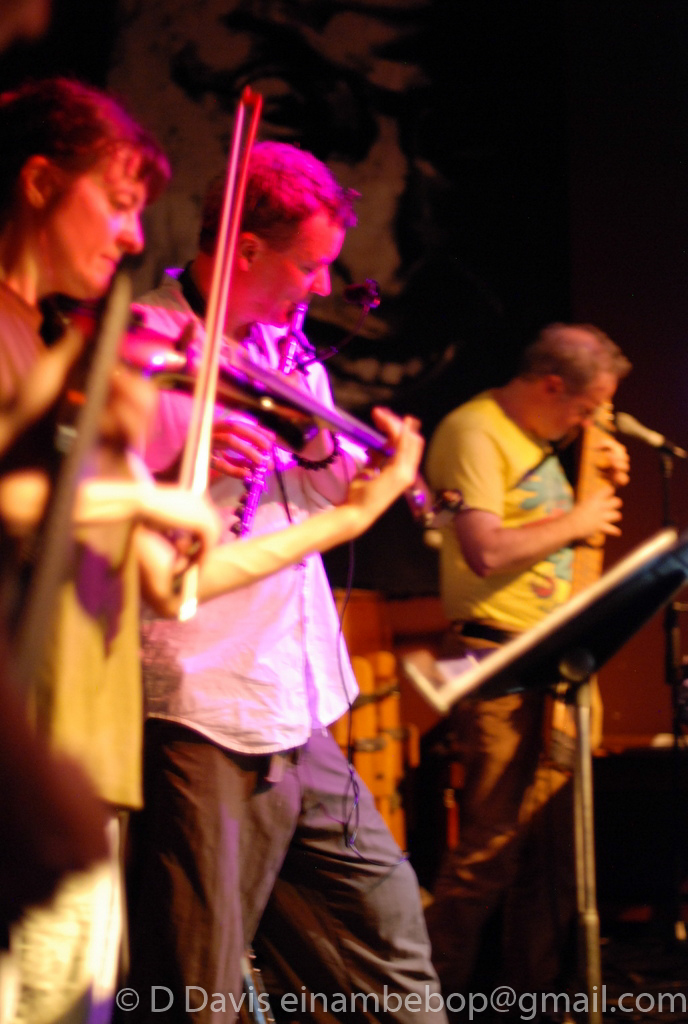 The festival kicked off with a free show at the Royal Room, one block south of the Columbia City Theater. First up was my own band, Zhongyu (the Mandarin Chinese word for "Finally"). I'll refrain from making any value judgments about the quality of the music, and just say we feature an unusual combination of instruments, including my own Chapman Stick and guzheng (a Chinese zither), electric violin from Alicia DeJoie, woodwinds from James DeJoie, Dennis Rea on guitar, and drummer Randy Doak. The DeJoies and Rea are all members of Moraine, though the repertoire is completely different in this band.
The festival kicked off with a free show at the Royal Room, one block south of the Columbia City Theater. First up was my own band, Zhongyu (the Mandarin Chinese word for "Finally"). I'll refrain from making any value judgments about the quality of the music, and just say we feature an unusual combination of instruments, including my own Chapman Stick and guzheng (a Chinese zither), electric violin from Alicia DeJoie, woodwinds from James DeJoie, Dennis Rea on guitar, and drummer Randy Doak. The DeJoies and Rea are all members of Moraine, though the repertoire is completely different in this band.
I use a rack of effects on both Stick and guzheng, adding loops and echoes to the traditional sound, and all the other instruments aside from the drums also use effects pedals. Moods ran the gamut from delicate arrangements for guzheng, bass clarinet, and violin, to odd-meter workouts. Several of the compositions are bridged together with improvised sections. While none of the pieces is actually based on traditional Chinese music, several feature sounds inspired by that part of the world. It's always hard judging your own performance, as how things feel on stage might be very different from what is experienced out in the room. But I came away from this feeling good — while not every note came out as planned, the energy was good, and my band-mates did justice to my compositions. I feel fortunate to work with musicians of this caliber.
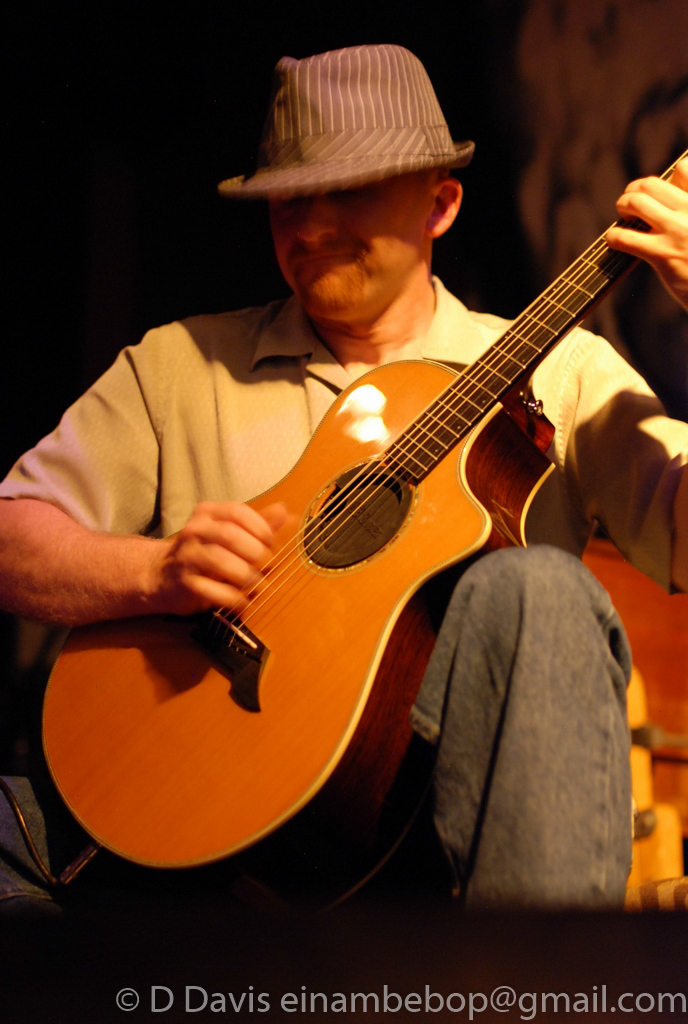 Next up was another Seattle band, MonkeyBat, a trio celebrating the release of their debut CD, Springtime Love. The band consists of drummer Vern Lawton, bassist Brian Todd, and acoustic guitarist Scott Lewis. Relying completely on acoustic guitar doesn't imply a lack of energy, however. Lewis is a master of rhythmic playing, working melodies into complex finger picking that varies from funky to classical and features tricky use of harmonics.
Next up was another Seattle band, MonkeyBat, a trio celebrating the release of their debut CD, Springtime Love. The band consists of drummer Vern Lawton, bassist Brian Todd, and acoustic guitarist Scott Lewis. Relying completely on acoustic guitar doesn't imply a lack of energy, however. Lewis is a master of rhythmic playing, working melodies into complex finger picking that varies from funky to classical and features tricky use of harmonics.
All three are superb instrumentalists, navigating the arrangements and sprinkling them with amazing flurries of notes, all the while staying on task to present music that is remarkably accessible in spite of the time changes and technical stretching that goes on. They also exhibited a healthy sense of humor, challenging each other to keep up. Todd's fluid playing on his six-string bass wowed the audience at several points during the set. A new piece called "Phantom Limb," written in honor of the festival, was played, and kept the musically astute in the audience on their toes with its changes. Vern claimed it was in 19/8, though independent confirmation of this claim has yet to be presented.
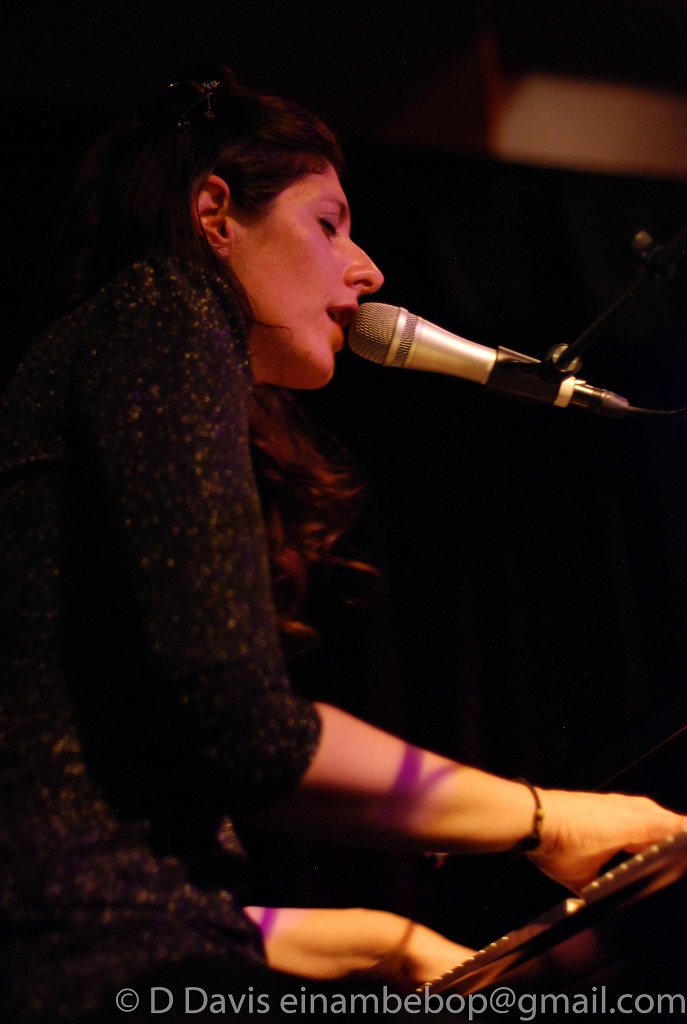 The evening finished off with Italian singer-songwriter Jolanda, also known as She-Owl. She accompanied her rich voice on the Royal Room's grand piano accompanied by Demian Endian on guitar and percussion. Her personal songs are filled with dreamlike imagery and deep emotional resonance, calling to mind other piano-women like Kate Bush and Tori Amos while sounding very little like anyone else. Demian's backing in particular sets the music outside the listener's expectations, providing textures and moods more than chords or notes. His percussive accents utilizing the drum kit on stage provided power and propulsion to the music, raising it above coffee-house confessionals.
The evening finished off with Italian singer-songwriter Jolanda, also known as She-Owl. She accompanied her rich voice on the Royal Room's grand piano accompanied by Demian Endian on guitar and percussion. Her personal songs are filled with dreamlike imagery and deep emotional resonance, calling to mind other piano-women like Kate Bush and Tori Amos while sounding very little like anyone else. Demian's backing in particular sets the music outside the listener's expectations, providing textures and moods more than chords or notes. His percussive accents utilizing the drum kit on stage provided power and propulsion to the music, raising it above coffee-house confessionals.
There were even moments of theater in the performance, when Demian took a heart pendant from Jolanda and held it to his own chest as he played. It was an emotionally satisfying end to a night of wide variety. Attendance was very good, giving us hope that we might actually pull this thing off.
The Royal Room is several steps above the bars where music is often presented, with a large stage, excellent sound, and a comfortable atmosphere. Donations turned out to be quite generous — since admission was free, the artists received only what was given freely by the crowd. Jolanda and Demian had to hit the road directly to get to the next stop on their West Coast tour, but most of the other musicians and attendees hung around to get acquainted after the show.
Saturday 29 June 2013, Day One
After a stop at Costco to pick up supplies for the Green Room, I arrived at the Theater around noon, just as Bone Cave Ballet was getting set up. The house soundman was very professional getting everything just right. I was also in charge of the stage lighting, so I took a few minutes to familiarize myself with the control board. Our volunteer photographer wanted light levels a little higher than is often seen at concerts to make sure we would get some good clear shots.
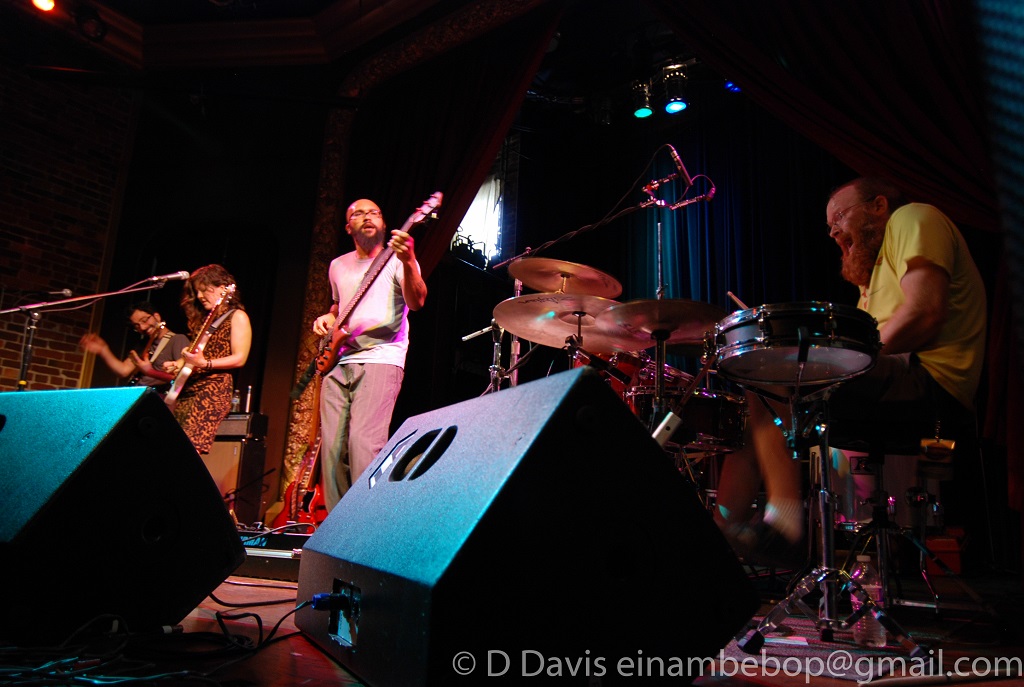 The festival proper started with a bang, courtesy of Bone Cave Ballet. The band has completed their second album (to be released this fall), and featured some of the new songs in addition to material from their debut CD, The Echo of Entropy (2009). Lead singer Jacqui Gilroy picked up a flute for one song. Drummer Kelly Mynes (with Gilroy, the only remaining member of the band from their debut) set the energy level for the band, attacking his kit with great force and driving the music forward through its meter changes and varying sections. As a special nod to the music that inspired the festival, they ended their set with a medley that included parts of Yes' "Long Distance Runaround" and "The Fish" and then transitioned into an original piece.
The festival proper started with a bang, courtesy of Bone Cave Ballet. The band has completed their second album (to be released this fall), and featured some of the new songs in addition to material from their debut CD, The Echo of Entropy (2009). Lead singer Jacqui Gilroy picked up a flute for one song. Drummer Kelly Mynes (with Gilroy, the only remaining member of the band from their debut) set the energy level for the band, attacking his kit with great force and driving the music forward through its meter changes and varying sections. As a special nod to the music that inspired the festival, they ended their set with a medley that included parts of Yes' "Long Distance Runaround" and "The Fish" and then transitioned into an original piece.
Their take on prog is decidedly their own, built upon Gilroy's strong, expressive voice and imaginative rhythm guitar, with the energy of punk but full of subtlety and skill. I had seen them play several times before, but they definitely stepped up to make this show special. The new lineup really works, and I'm looking forward to that new CD.
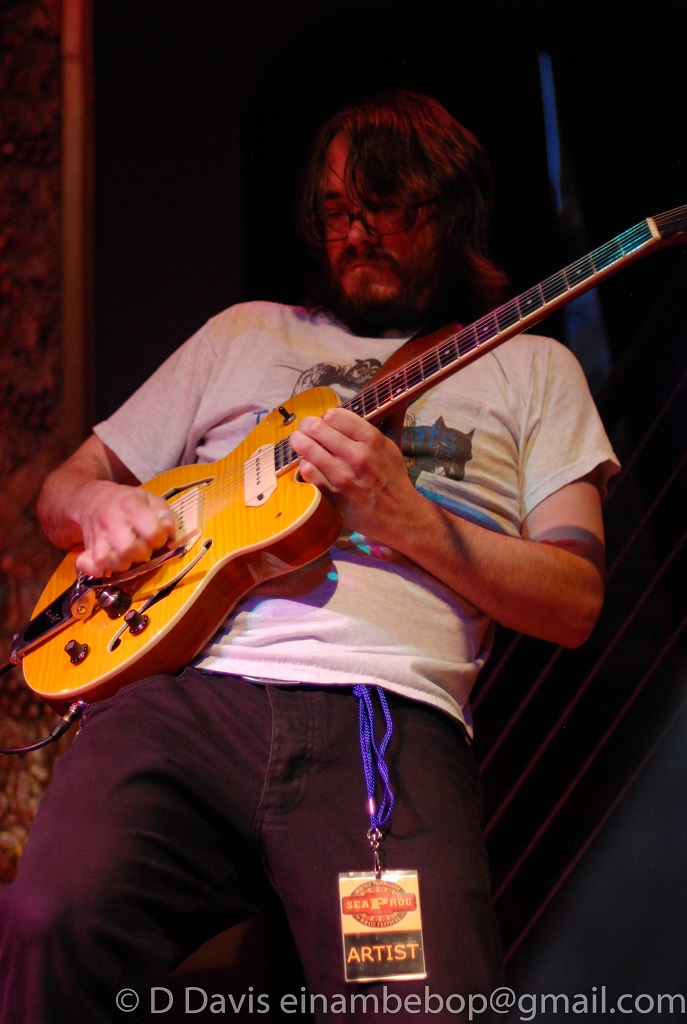 Trimtab proved to be one of the big surprises of the festival. I don't know how many times I've seen them play, but they got sneaky on us for this show. Their set started in a deceptively simple manner: the trio of Jason Goessl (guitar), Phil Cali (bass), and Brian Oppel (drums) began with a loping piece with a dub-influenced style, lots of echo and a sparse reggae beat. But it wasn't long before the crowd was treated to some jaw-dropping fusion fire, with lightning-fast unison licks and blistering solos. The band has a new CD recorded and headed toward release. It will no doubt be a much better representation of this band's sound than their debut from 2009, which featured acoustic guitar and some electronics. Goessl's mastery of jazz, surf, and country styles shows up in the many unexpected juxtapositions in the arrangements.
Trimtab proved to be one of the big surprises of the festival. I don't know how many times I've seen them play, but they got sneaky on us for this show. Their set started in a deceptively simple manner: the trio of Jason Goessl (guitar), Phil Cali (bass), and Brian Oppel (drums) began with a loping piece with a dub-influenced style, lots of echo and a sparse reggae beat. But it wasn't long before the crowd was treated to some jaw-dropping fusion fire, with lightning-fast unison licks and blistering solos. The band has a new CD recorded and headed toward release. It will no doubt be a much better representation of this band's sound than their debut from 2009, which featured acoustic guitar and some electronics. Goessl's mastery of jazz, surf, and country styles shows up in the many unexpected juxtapositions in the arrangements.
While Goessl is clearly the leader of this band, he's no attention-hog. Calli's dextrous bass playing is often modified by effects, sometimes booming out with massive fuzz, sometimes twisted into weird harmonics. And Oppel is quite an idiosyncratic drummer, frequently playing his kit in non-standard ways, and augmenting it with a variety of found objects. At one point he had a variety of loose cymbals that he stacked onto his drums and bashed into each other chaotically. This set also featured the first broken string of the day. Normally that wouldn't be a notable event, but it was on Calli's bass, and he finished the set on a borrowed instrument.
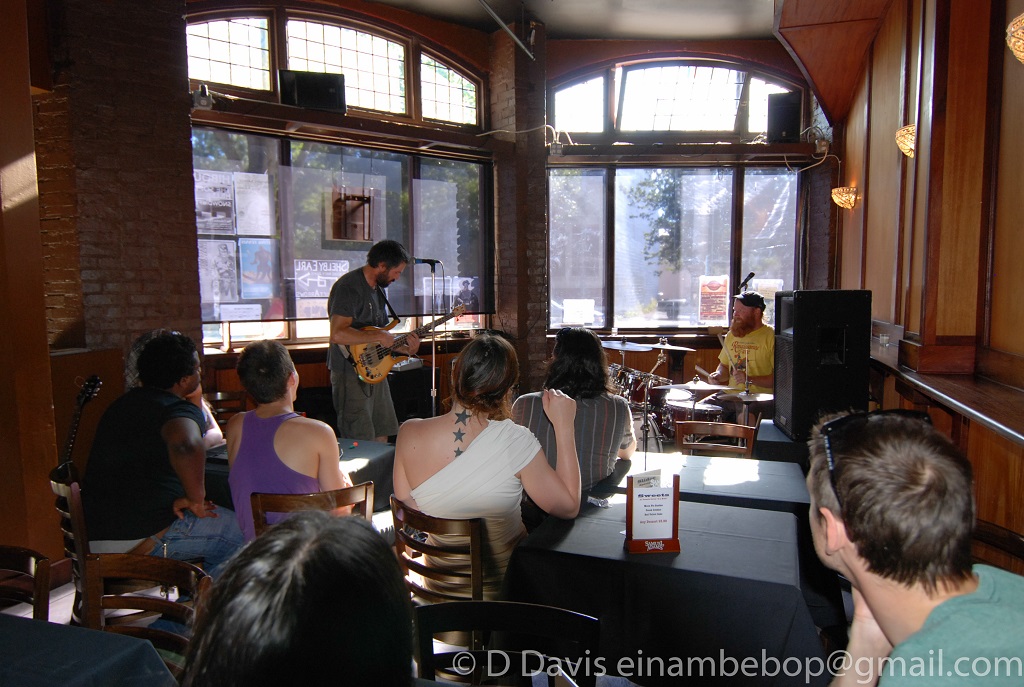 During the break between the afternoon and evening performances on the main stage, the Theater's front room hosted Austenitic, a bass-drums duo bringing punk energy and a dose of humor to their tightly arranged material. They've been called "Seattle's answer to Ruins" (by more than just me, I think) and the comparison is not far off base. Even without the use of loops (which he did utilize at times), bassist Ross Martin fills the room with his sound, playing chords and melodies in addition to the "bass parts." The drummer is Bone Cave Ballet's Kelly Mynes, bringing his pummeling energy to a very different setting. I was busy restocking the Green Room and getting the lights set up for the next act, so I didn't get to hear the whole Austenitic set, but I can attest that it was very loud and the bartender was enjoying it.
During the break between the afternoon and evening performances on the main stage, the Theater's front room hosted Austenitic, a bass-drums duo bringing punk energy and a dose of humor to their tightly arranged material. They've been called "Seattle's answer to Ruins" (by more than just me, I think) and the comparison is not far off base. Even without the use of loops (which he did utilize at times), bassist Ross Martin fills the room with his sound, playing chords and melodies in addition to the "bass parts." The drummer is Bone Cave Ballet's Kelly Mynes, bringing his pummeling energy to a very different setting. I was busy restocking the Green Room and getting the lights set up for the next act, so I didn't get to hear the whole Austenitic set, but I can attest that it was very loud and the bartender was enjoying it.
 Operation ID opened the evening with a set of complex, melodic prog-pop remiscent of Gentle Giant, XTC, and They Might Be Giants, all presented in an unpredictable style. Complex vocal arrangements (all five sang at various times) and countermelodies are their stock in trade. It was partway into their set that we saw the day's second bass string break.
Operation ID opened the evening with a set of complex, melodic prog-pop remiscent of Gentle Giant, XTC, and They Might Be Giants, all presented in an unpredictable style. Complex vocal arrangements (all five sang at various times) and countermelodies are their stock in trade. It was partway into their set that we saw the day's second bass string break.
Their onstage antics resulted in a bit of bloodshed at the end of the set: guitarist Jared Borkowski fell and gouged his chin after leaping off the bass amp, later requiring stitches at a local hospital. But no lasting damage was done — it was all in good fun. It was while I was onstage doing my little announcements that I noticed Jared was still down and that he was bleeding, so I made it quick and went in search of a first aid kit.
Oddly enough, they announced that this would be one of their final shows. In spite of the impending release of their second CD, they are apparently splitting up soon, leaving us to wonder what will happen to all of this incredible energy and talent. This is a new generation of progressive rock, seemingly free of the stigma that has been our burden since the onslaught of punk in the late 70s. Their music is complex and unpredictable, and never fails to bring a smile to my face.
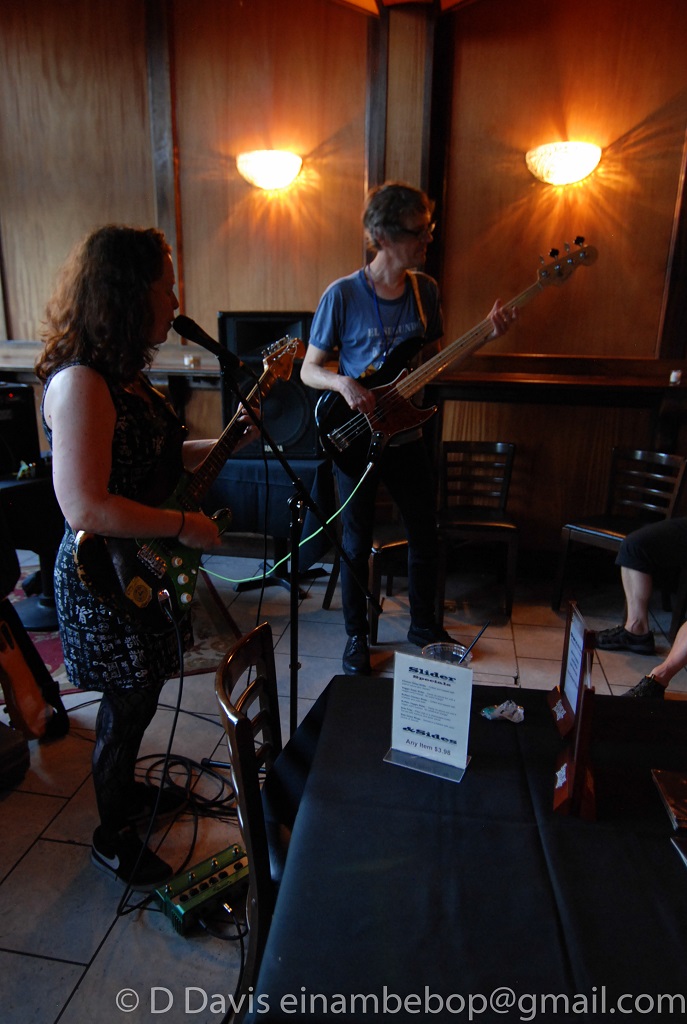 During the soundcheck break, Amy Denio and Fred Chalenor got together in the front room for a Tone Dogs reunion of sorts. Many amusing anecdotes introduced the songs. Some tunes were done with bass and guitar, others with two basses. The adventurous spirit that proved so engaging on Ankety Low Day (1990) is still very much alive, even though the band is long gone.
During the soundcheck break, Amy Denio and Fred Chalenor got together in the front room for a Tone Dogs reunion of sorts. Many amusing anecdotes introduced the songs. Some tunes were done with bass and guitar, others with two basses. The adventurous spirit that proved so engaging on Ankety Low Day (1990) is still very much alive, even though the band is long gone.
This low-key presentation was representative of the kind of quirky charm Seaprog aimed for. In this era of mega-festivals like Coachella and South by Southwest, there's room for such modest gems, reminding us that good music comes in many shapes and sizes. I wish I'd been able to see more of their performance, but I was backstage helping Jared get the bleeding stopped.
By the time I got back into the Theater, miRthkon were getting set up, and I was afraid our schedule was going down the tubes. Their setup is highly technical — they brought their own soundman and mixing board, all of which was patched into the house sound system. In the festival's most high-tech set, the band members all wore in-ear monitors or headphones controlled by their iPhones. But it all came together and we were able to open the doors only a few minutes behind schedule.
Oakland's miRthkon finished off the evening with a roar. Elements of RIO blend abruptly with intense heavy metal, and melodies are tossed around between the parts like the proverbial hot potato. A special treat was "Bari's Wear Foots," a version of the Black Sabbath classic "Fairies Wear Boots" arranged with two bari saxes and a baritone guitar that the band originally contributed to a tribute album (Paranoid, a "Bay Area Musical Collaboration").
 By miRthkon's example, it is entirely possible to "rock out with your score out," cranking out some amazing sounds from behind their music stands. Much of the material came from their outstanding 2009 album, Vehicle. and their more recent video release, (format). The lineup of two saxes (swapped out with clarinet, bass clarinet, and so on) with two guitars gives them a lot of voices to work with, and they rarely function in standard chordal roles, instead presenting enough amped-up polyphony to keep listeners' heads spinning. It's like Sleepytime Gorilla Museum crossed with 5uu's.
By miRthkon's example, it is entirely possible to "rock out with your score out," cranking out some amazing sounds from behind their music stands. Much of the material came from their outstanding 2009 album, Vehicle. and their more recent video release, (format). The lineup of two saxes (swapped out with clarinet, bass clarinet, and so on) with two guitars gives them a lot of voices to work with, and they rarely function in standard chordal roles, instead presenting enough amped-up polyphony to keep listeners' heads spinning. It's like Sleepytime Gorilla Museum crossed with 5uu's.
After such a musical (and volume) high, there was only a short bit of hanging out in the Green Room with beer and chips chatting with musicians — and cleaning up the mess left behind from a whole day of activity. Then it was home for some rest.
Sunday 30 June 2013, Day Two
Sunday, like Saturday, started with a Costco run to replenish supplies — musicians will consume a fair amount of beer when it's free for the taking! Setup was well underway when I arrived. I stowed the refreshments and fired up the light board, only to find that everything I'd learned about it on Saturday no longer applied. After powering up, it was in a different mode or preset or something, so the fader that previously controlled the blue light above stage left now controlled a purple one at the back. There wasn't anyone around to show me how it worked, so I just experimented until everyone on stage was covered. Luckily, Dennis volunteered to bring me a latte to keep me going.
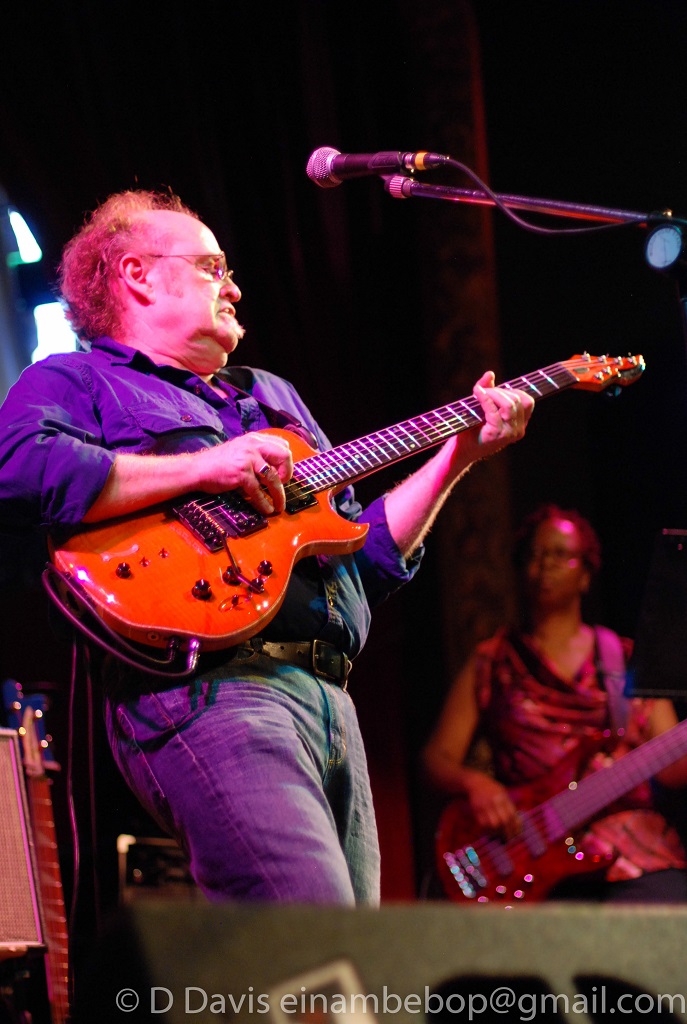
Dissonati began Day Two with the debut of their new lineup and a special treat by adding a string trio to their set. Atter the departure of their previous bassist to Reno for a job opportunity, the band found Alicia Rinehart, who also plays violin and viola. Taking advantage of the new member's talents, a cellist and violinist were recruited to play on the set's final two selections, greatly enhancing the drama and impact of Dissonati's dark version of progressive rock.
Dissonati was probably the festival's most traditionally progressive band, though they're certainly not copycats of any particular classic prog band. They exhibit the dark seriousness of Van der Graaf Generator, though it's more a mood thing than a similarity in sound. Ron Rutherford's guitar varies from spacy effects to flashy solos; and John Hagelbarger's keys, sax, and flute provide a lot of color, relying mostly on vintage sounds produced by modern instruments. John Reagan's electronic drum kit is a polarizing feature, on the one hand giving the band's music a very different flavor, but limiting the expression at times; he also triggered some voice samples and the like.
I've seen Dissonati play a number of times, including their very first public appearance at a barbeque in John's back yard, and they have gotten better every time. The vocals, from both Rutherford and Hagelbarger, are their weakest point, but the music is mostly instruemental, and the addition of the string section really pulls it up to a new level of sophistication.
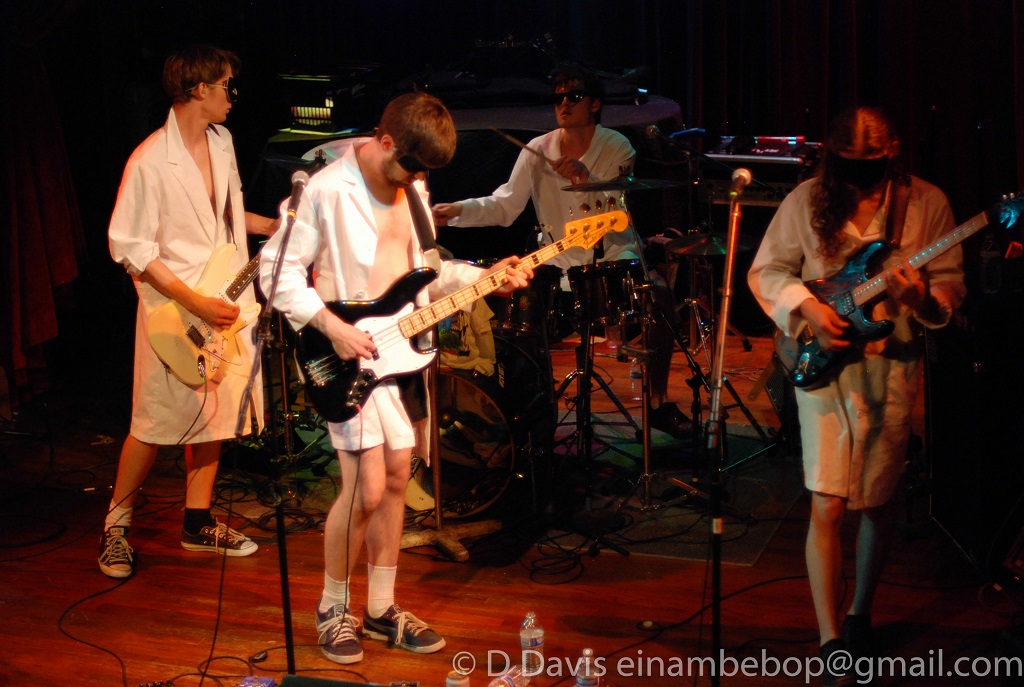 Alex's Hand brought their Zappa/Beefheart brand of prog to the stage with a wandering continuous set. All kinds of rock, from blues to punk to metal, are in bounds for this band, as in another of their influences, Mr Bungle. Even though their full-length debut, Albatross around the Neck, was just out, their set featured only bits and pieces of it, strewn together with humorous banter and weird diversions.
Alex's Hand brought their Zappa/Beefheart brand of prog to the stage with a wandering continuous set. All kinds of rock, from blues to punk to metal, are in bounds for this band, as in another of their influences, Mr Bungle. Even though their full-length debut, Albatross around the Neck, was just out, their set featured only bits and pieces of it, strewn together with humorous banter and weird diversions.
In a festival filled with performers who stepped onstage wearing ordinary street clothes, Alex's Hand presented a different visual impact with their masks and lab coats over shorts. This look didn't seem to relate to any particular theme, but is more a representative of their absurdist humor — though "mad scientists" isn't an off-base description of their modus operandi. They are one of Seattle's most original rock bands, always entertaining in spite of the underlying complexity.
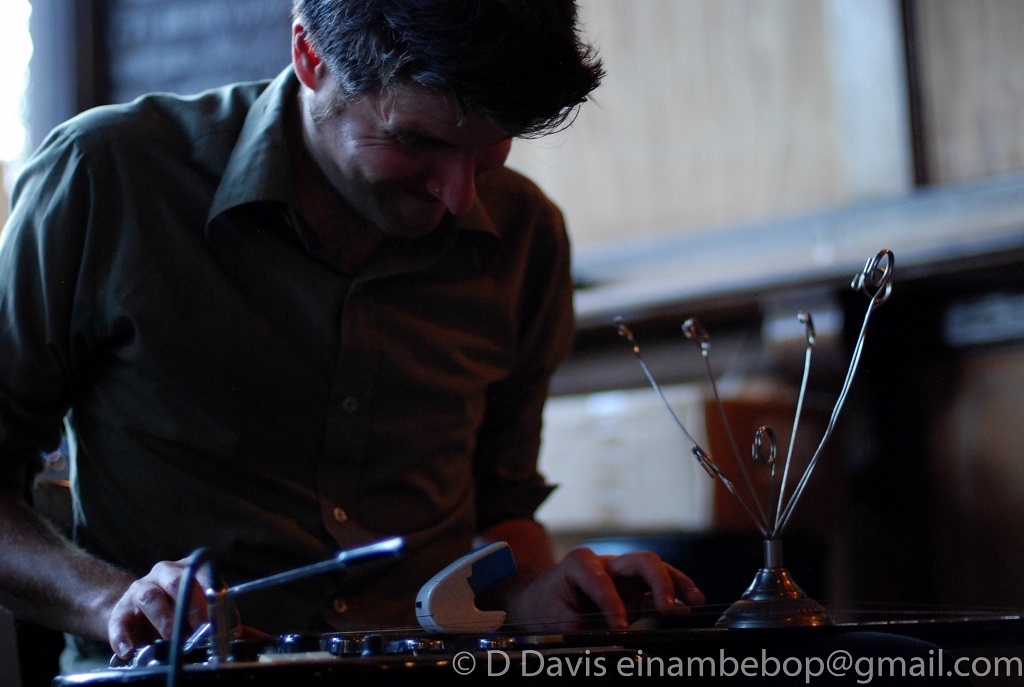 Then it was out to the front room, where Bill Horist did "unspeakable things" to a guitar. His improvised set included a wide variety of unusual ways to get noises out of his instrument. A variety of effects devices assisted his quest for the outer limits of sonic possibilities. Bowing, tapping, beating with sticks, eBow and more all figured into the mix. If you had closed your eyes, most of the time you would never guess that a guitar was involved. At one point, I noticed a passer-by outside peering in the window, probably wondering what the hell was going on inside.
Then it was out to the front room, where Bill Horist did "unspeakable things" to a guitar. His improvised set included a wide variety of unusual ways to get noises out of his instrument. A variety of effects devices assisted his quest for the outer limits of sonic possibilities. Bowing, tapping, beating with sticks, eBow and more all figured into the mix. If you had closed your eyes, most of the time you would never guess that a guitar was involved. At one point, I noticed a passer-by outside peering in the window, probably wondering what the hell was going on inside.
I caught a fair portion of his performance, and slipped next door for my first real sit-down meal of the weekend at Tutta Bella.
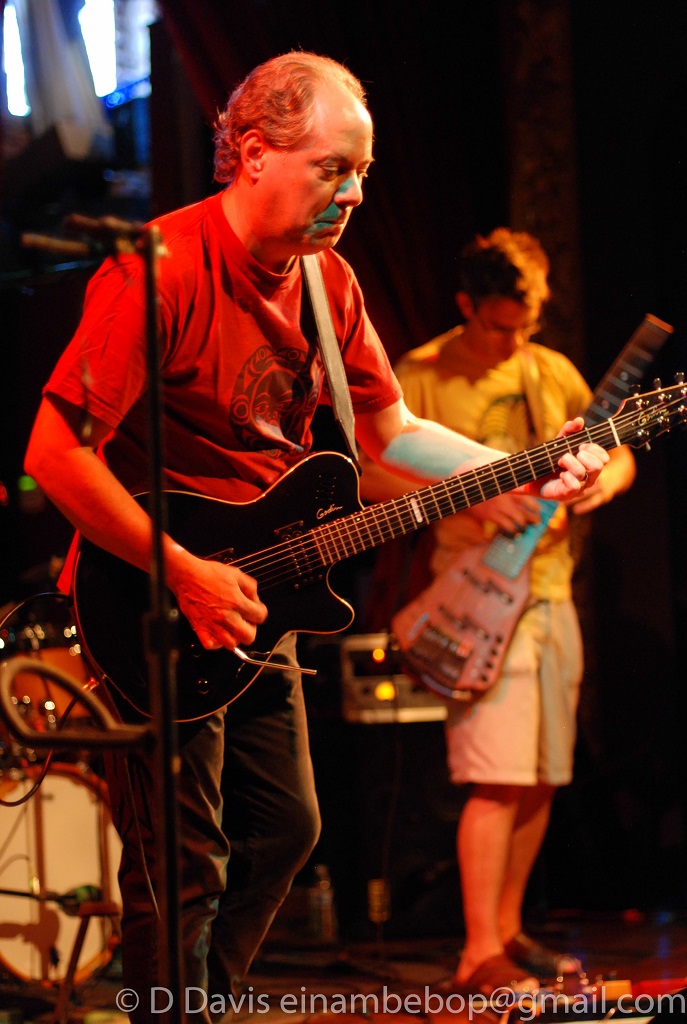 The final evening of the festival started with Moraine, another band I've seen multiple times, in settings ranging from biker bars to informal clubs of uncertain legality to the DeJoies' living room. But for this outing, Moraine had a special guest for the start of their set: composer David Gaines provided keyboard drone accompaniment for a piece showcasing Alicia DeJoie's violin.
The final evening of the festival started with Moraine, another band I've seen multiple times, in settings ranging from biker bars to informal clubs of uncertain legality to the DeJoies' living room. But for this outing, Moraine had a special guest for the start of their set: composer David Gaines provided keyboard drone accompaniment for a piece showcasing Alicia DeJoie's violin.
The regular five-piece continued with a variety of selections from their two Moonjune albums as well as several newer additions to their repertoire. New drummer Tom Zgonc brings a different energy to the band, with a more flexible, jazzy approach than what is found on Manifest Density or Metamorphic Rock. A new tune called "Skein," with an especially tricky rhythmic motif, really wowed the audience. I was really thrilled to see this band on a proper stage with good sound, and I've got a feeling their next CD is going to really cook. Probably my favorite of all the times I've seen them perform.
And finally it was time for Thinking Plague, a legendary avant-prog outfit with a thirty-year history in spite of rather sparse recorded output. Being able to bring this band to Seattle for the first time was one of our greatest accomplishments as festival organizers. Composer Mike Johnson was backed by longtime allies Dave Willey and Mark Harris; Kimara Sajn and Elaine DiFalco have a history with the band, though shorter tenure; Bill Pohl (Underground Railroad) and Robin Chestnutt are the relative newcomers. Many Plague classics made it into the set: "Maelstrom," "Love," "Behold the Man," and "Consolamentum" all appeared.
Thinking Plague, a legendary avant-prog outfit with a thirty-year history in spite of rather sparse recorded output. Being able to bring this band to Seattle for the first time was one of our greatest accomplishments as festival organizers. Composer Mike Johnson was backed by longtime allies Dave Willey and Mark Harris; Kimara Sajn and Elaine DiFalco have a history with the band, though shorter tenure; Bill Pohl (Underground Railroad) and Robin Chestnutt are the relative newcomers. Many Plague classics made it into the set: "Maelstrom," "Love," "Behold the Man," and "Consolamentum" all appeared.
I lieu of having a second singer, DiFalco used a keyboard to harmonize her own voice as she sang, filling out the sound and providing a somewhat other-worldly tone. She also stretched the boundaries of progressive rock by playing a ukulele. The world is a richer place for having such brilliant and idiosyncratic music in it. I found myself on the walkway above the side of the theater grinning like an idiot as their set unfolded. Yes, this is what music is all about.
And then it was over. Dennis and John joined me on stage for some farewell thoughts. We expressed our gratitude to the musicians, the venue staff, our volunteers, and the fans who came. For sure, our attendance wasn't in the thousands, but that's not what we were aiming for, and the Columbia City Theater wouldn't hold a thousand people anyway. We were gratified by all the positive feedback we got from fans and participants alike — everyone we spoke to was very appreciative, and we got several encouraging words about doing it again in 2014.
The following week, the Central Committee had a postmortem meeting, and we were rested up enough to commit ourselves to Mk. II. The Theater staff had already contacted us saying they felt it was a success and wanted us to have another go. It will be several months before we're ready to start thinking about booking bands, but the dates are set for June 21-22, 2014. We'll want to do a Friday night pre-show again, though we haven't finalized anything on that.
Filed under: Festivals
Related artist(s): Bone Cave Ballet, James DeJoie, Dissonati, Bill Horist, Moraine, Dennis Rea, Trimtab, Thinking Plague, Tone Dogs, miRthkon, Jolanda Moletta / She Owl, MonkeyBat, Alex's Hand, Operation ID, Zhongyu / Super Z Attack Team, Amy Denio, Fred Chalenor
More info
http://www.seaprogfest.org
What's new
These are the most recent changes made to artists, releases, and articles.
- Release: 8x8 - New Data New Day
Updated 2024-04-24 12:13:42 - Review: Aglaia - Inner Enchantments
Published 2024-04-24 - Release: 8x8 - Life During Wartime
Updated 2024-04-23 17:55:39 - Review: Cheer-Accident - Vacate
Published 2024-04-23 - Release: s475e - Next Stop Earth
Updated 2024-04-22 16:06:30 - Artist: s475e (Darius Speier)
Updated 2024-04-22 16:05:44 - Release: Jim Black & the Shrimps - Ain't No Saint
Updated 2024-04-22 15:59:58 - Release: Jim Black Trio - Reckon
Updated 2024-04-22 15:58:55 - Release: Jim Black - Malamute
Updated 2024-04-22 15:57:31 - Release: Jim Black Trio - The Constant
Updated 2024-04-22 15:56:17 - Release: Natsuki Tamura / Jim Black - NatJim
Updated 2024-04-22 15:54:36 - Release: Mono - Oath
Updated 2024-04-22 15:49:48 - Release: The Cyberiam - Unobtainium
Updated 2024-04-22 15:46:54 - Release: Pete Ham - Keyhole Street
Updated 2024-04-22 15:44:27 - Release: Pete Ham - Golders Green
Updated 2024-04-22 15:43:29 - Release: Pete Ham - 7 Park Avenue
Updated 2024-04-22 15:41:03 - Release: Human Feel - Gold
Updated 2024-04-22 15:35:23 - Release: Ikue Mori - Obelisk
Updated 2024-04-22 15:33:39 - Release: Human Feel - Galore
Updated 2024-04-22 15:25:33 - Release: David Binney - Balance
Updated 2024-04-22 15:20:23
